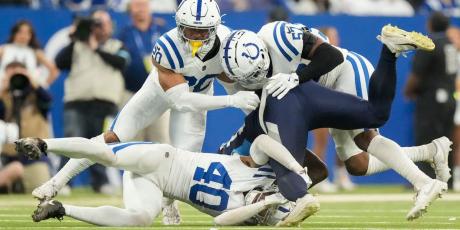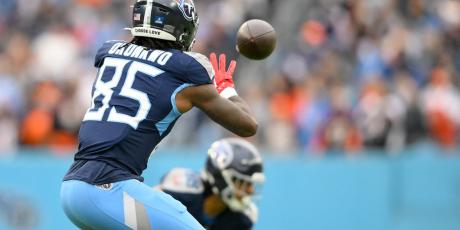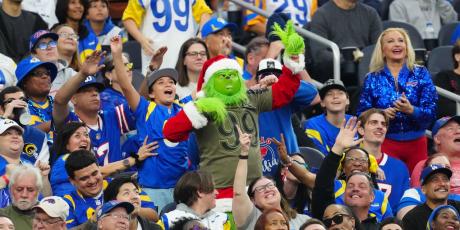The Case for Quarterback by Waiver Wire: Part 1

Beyond the stats, beyond the arguments for and against paying premium prices for fantasy football’s top signal callers, beyond the risk associated with playing matchups, there are the underlying trends: teams are passing more than ever as we see up-tempo, spread offenses take hold, and the number of exploitable defenses is on the rise.
The installation of pass-heavy offensive schemes is a boon for fantasy football owners, but only if you allow it to be, as the very definition of what it means to be a volume thrower of the pigskin has changed in a few short years.
At 4for4 this season I will be writing a weekly column, QB by Waiver Wire, designed to guide you through the waiver wire, spotting undervalued and extraordinarily useful quarterback options who are eminently capable of putting up QB1 (top-12) numbers. Follow along and you’ll stun your league mates who are tragically married to the plug-and-play method.
A quarterback by waiver wire approach – one that paid dividends for me in 2012 – is unquestionably uncomfortable and not for the risk averse, but with careful evaluation of weekly matchups using 4for4 tools and a little foresight, relying on fantasy commodities well outside of the top options can net almost the same amount of fantasy points over the course of the season as their superior, plug-and-play options.
In other words, a well-played conglomeration of Sam Bradford, Alex Smith, Jay Cutler, Ryan Tannehill, Brandon Weeden, and Carson Palmer can come close to matching Drew Brees in season-long production. That’s probably fantasy football sacrilege.
Sacrilege or not, it’s true.
The unquestioned advantage to relying on streamable quarterbacks, of course, is being able to stack your lineup and bench with reliable running backs and wide receivers, making your fantasy squad far less reliant on a single stud, and far less susceptible to succumbing to a single injury. Your team’s depth will provide the cushion.
However you feel about a quarterback by waiver wire approach, this much is undeniable: there are more useable fantasy signal callers than ever before. We just have to find them.
Not a single quarterback eclipsed 600 pass attempts in 2009, when 14 quarterbacks threw more than 500 passes. Three years later, fantasy owners saw 18 quarterbacks throw at least 500 passes and six guys crossed the 600-throw threshold, including the reigning king of volume throwing, Matthew Stafford, who chucked the rock 727 times.
The following chart shows that it’s not just the elite signal callers who have seen a boost in pass attempts. It’s everyone, including the 10 starting quarterbacks who threw the fewest number of passes in 2012. We see, once again, that definition of high-volume and low-volume throwers has shifted.
2009 vs. 2012 Passing Tendencies
| Year | 10 QBs with Most Pass Attempts | 10 QBs with the Fewest Passes |
|---|---|---|
| 2009 | 30.7 attempts per game | 27.1 attempts per game |
| 2012 | 38.6 attempts per game | 29.5 attempts per game |
The cavernous gap between pass-happy quarterbacks from 2009 and 2012 is the most striking, though the increase of two pass attempts per game among the 10 guys who threw the least shouldn’t be overlooked. It should also be noted that in using the waiver wire to find our quarterback, we’re not often scooping up guys whose attempts will be limited.
If part of our evaluation of a fantasy commodity is the opportunity he has in a given week or season, this spike in pass attempts should offer fantasy owners more viable weekly quarterback options.
What’s that, you say? Oh, we’ve seen this very thing come to fruition?
Why yes. Yes, we have.
Thirty-eight quarterbacks scored in the top-12 (known as QB1 territory) at least once in 2012, with 26 signal callers reaching top-12 status at least four times, according to research conducted by JJ Zachariason. That means, as you may have deduced, that 25 quarterbacks proved to be startable fantasy options in four or more weeks. Our options, as I’ve said, have grown, and not by a little.
Happily for those who are willing to stream their quarterbacks with so many weekly options, it’s not just the increased opportunities that lend credence to the strategy, but the number of defenses that prove exploitable to the pass.
Fantasy DEFs vs QBs
| Year | DEFs allowing 15+ PPG to QBs | DEFs allowing 11 or fewer PPG to QBs |
|---|---|---|
| 2010 | 8 | 10 |
| 2011 | 18 | 5 |
| 2012 | 15 | 4 |
The above chart shows that while the number of defenses that have proven sieve-like against fantasy quarterbacks has increased, the number of defenses that strike fear in the hearts of quarterback streamers has been on a steady decline. There were only four defensive units I avoided last year in my streaming signal caller experiment – more proof that our weekly options have expanded.
If the chart tells us anything, it’s that there’s less to fear in committing to a quarterback by waiver wire approach.
The influx of exploitable defenses -- no doubt a result of more offenses turning to spread formations and pass-heavy attacks -- is as important in quarterback streaming as the aforementioned jump in useable weekly quarterbacks. Knowing that a defense is among the three or five or even ten most generous to fantasy quarterbacks, we can plan ahead in our waiver wire manipulation. Targeting defenses that have proven most susceptible to the pass, we can iron out our streaming strategy several weeks in advance.
It’s important to evaluate any and all new information that could change our valuation of quarterbacks in the meantime, but stashing a waiver wire signal caller three weeks before he goes against a horrendous secondary is central to long-term streaming success.
Fantasy owners will buck at the very concept of drafting quarterbacks late and using the waiver wire to find the best available weekly matchups. Plug-and-play options, as you know, are far more comfortable. Set it and forget it, you might hear from a fake footballer who pays the heavy price for Aaron Rodgers or Drew Brees or Cam Newton.
What the setters and forgetters are ignoring, however, is the inherent devaluation of the quarterback position in standard fantasy leagues. The quarterback market has undergone a dramatic and permanent shift. There are more guys throwing more passes in more pass-friendly offensive schemes than ever before, and working the waiver wire is the most effective way to take advantage of this market change.
In the second part of this series, I’m going to guide you through all 16 weeks of my 2012 experiment with the quarterback by waiver wire approach, showing that foresight and trust in statistical evaluations and trends can net almost as many fantasy points as the plug-and-play advocates, who pay a premium for the luxury of a Rodgers.
In Part Three, I’ll pinpoint seven quarterbacks available in the 10th round or later who should be foremost on your mind this summer. All seven guys, as you may have guessed, are going to see an uptick in pass attempts that hasn’t yet been factored into their fantasy value, making them borderline extreme draft day values and ideal streamable options.






















